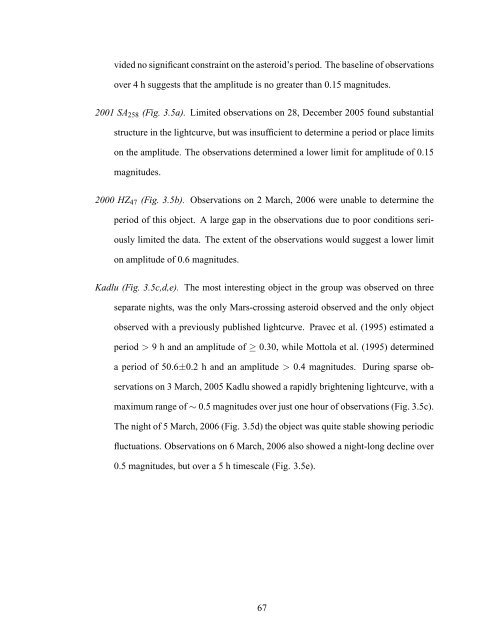Forming Binary Near-Earth Asteroids From Tidal Disruptions
Forming Binary Near-Earth Asteroids From Tidal Disruptions
Forming Binary Near-Earth Asteroids From Tidal Disruptions
Create successful ePaper yourself
Turn your PDF publications into a flip-book with our unique Google optimized e-Paper software.
vided no significant constraint on the asteroid’s period. The baseline of observationsover 4 h suggests that the amplitude is no greater than 0.15 magnitudes.2001 SA 258 (Fig. 3.5a). Limited observations on 28, December 2005 found substantialstructure in the lightcurve, but was insufficient to determine a period or place limitson the amplitude. The observations determined a lower limit for amplitude of 0.15magnitudes.2000 HZ 47 (Fig. 3.5b). Observations on 2 March, 2006 were unable to determine theperiod of this object. A large gap in the observations due to poor conditions seriouslylimited the data. The extent of the observations would suggest a lower limiton amplitude of 0.6 magnitudes.Kadlu (Fig. 3.5c,d,e). The most interesting object in the group was observed on threeseparate nights, was the only Mars-crossing asteroid observed and the only objectobserved with a previously published lightcurve. Pravec et al. (1995) estimated aperiod > 9 h and an amplitude of ≥ 0.30, while Mottola et al. (1995) determineda period of 50.6±0.2 h and an amplitude > 0.4 magnitudes. During sparse observationson 3 March, 2005 Kadlu showed a rapidly brightening lightcurve, with amaximum range of ∼ 0.5 magnitudes over just one hour of observations (Fig. 3.5c).The night of 5 March, 2006 (Fig. 3.5d) the object was quite stable showing periodicfluctuations. Observations on 6 March, 2006 also showed a night-long decline over0.5 magnitudes, but over a 5 h timescale (Fig. 3.5e).67












